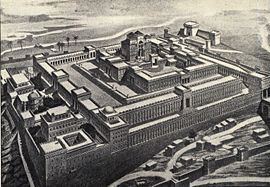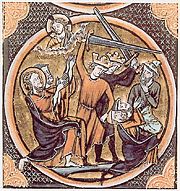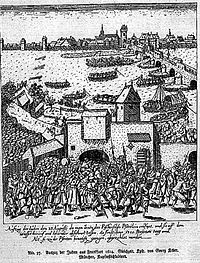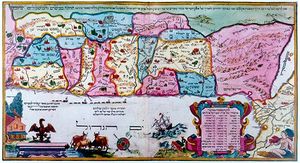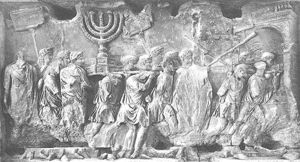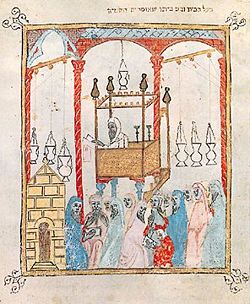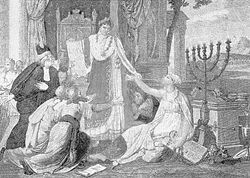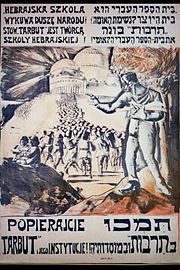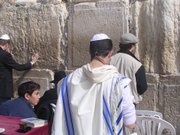Jew
2008/9 Schools Wikipedia Selection. Related subjects: Peoples
| Jews יְהוּדִים (Yehudim) |
|||||||||||||||||||||||||||||||||||||||||||||||||||||||||||||||||||||||||||
|---|---|---|---|---|---|---|---|---|---|---|---|---|---|---|---|---|---|---|---|---|---|---|---|---|---|---|---|---|---|---|---|---|---|---|---|---|---|---|---|---|---|---|---|---|---|---|---|---|---|---|---|---|---|---|---|---|---|---|---|---|---|---|---|---|---|---|---|---|---|---|---|---|---|---|---|
 Albert Einstein • Maimonides • Golda Meir • Emma Lazarus
|
|||||||||||||||||||||||||||||||||||||||||||||||||||||||||||||||||||||||||||
| Total population | |||||||||||||||||||||||||||||||||||||||||||||||||||||||||||||||||||||||||||
|
Estimated 13 million |
|||||||||||||||||||||||||||||||||||||||||||||||||||||||||||||||||||||||||||
| Regions with significant populations | |||||||||||||||||||||||||||||||||||||||||||||||||||||||||||||||||||||||||||
|
|||||||||||||||||||||||||||||||||||||||||||||||||||||||||||||||||||||||||||
| Languages | |||||||||||||||||||||||||||||||||||||||||||||||||||||||||||||||||||||||||||
|
Historical Jewish languages: |
|||||||||||||||||||||||||||||||||||||||||||||||||||||||||||||||||||||||||||
| Religions | |||||||||||||||||||||||||||||||||||||||||||||||||||||||||||||||||||||||||||
| Judaism | |||||||||||||||||||||||||||||||||||||||||||||||||||||||||||||||||||||||||||
| Related ethnic groups | |||||||||||||||||||||||||||||||||||||||||||||||||||||||||||||||||||||||||||
| Arabs and other Semitic groups |
A Jew (Hebrew: יְהוּדִי, Yehudi ( sl.); יְהוּדִים, Yehudim ( pl.); Ladino: ג׳ודיו, Djudio ( sl.); ג׳ודיוס, Djudios ( pl.); Yiddish: ייִד, Yid (sl.); ייִדן, Yidn (pl.)) is a member of the Jewish people, an ethnoreligious group originating in the Israelites or Hebrews of the ancient Middle East. The ethnicity and the religion of Judaism, the traditional faith of the Jewish nation, are strongly interrelated, and converts to Judaism are both included and have been absorbed within the Jewish people throughout the millennia.
The Jews have suffered a long history of persecution in many different lands, and their population and distribution per region has fluctuated throughout the centuries. Today, most authorities place the number of Jews between 12 and 14 million, representing 0.2% of the current estimated world population. According to the Jewish Agency, for the year 2007 there are 13.2 million Jews worldwide; 5.4 million (40.9%) in Israel, 5.3 million (40.2%) in the United States, and the remainder distributed in communities of varying sizes around the world. These numbers include all those who consider themselves Jews whether or not affiliated, and, with the exception of Israel's Jewish population, do not include those who do not consider themselves Jews or who are not Jewish by halakha. The total world Jewish population, however, is difficult to measure. In addition to halakhic considerations, there are secular, political, and ancestral identification factors in defining who is a Jew that increase the figure considerably.
Jews and Judaism
The origin of the Jews is traditionally dated to around the second millennium BCE in Mesopotamia, where the destruction of Ur and Chaldees caused a population movement. Abraham's family was among those migrating to Assyria. Abraham is considered the first founder of Judaism.
The Merneptah Stele, dated to 1200 BCE, is one of the earliest archaeological records of the Jewish people in the Land of Israel, where Judaism, the first monotheistic religion, developed. According to Biblical accounts, the Jews enjoyed periods of self-determination first under the Biblical judges from Othniel through Samson, then circa 1000 BCE King David established Jerusalem as the capital of the United Kingdom of Israel and Judah, also known as the United Monarchy, and from there ruled the Twelve Tribes of Israel.
In 970 BCE, David's son Solomon became king of Israel. Within a decade, Solomon began to build the Holy Temple known as the First Temple. Upon Solomon's death (c. 930 BCE), the ten northern tribes split off to form the Kingdom of Israel. In 722 BCE the Assyrians conquered the Kingdom of Israel and exiled its Jews, starting a Jewish diaspora. At a time of limited mobility and travel, Jews became some of the first and most visible immigrants. Then as now, immigrants were treated with suspicion.
The First Temple period ended around 586 BCE as the Babylonians conquered the Kingdom of Judah and destroyed the Jewish Temple. In 538 BCE, after fifty years of Babylonian captivity, Persian King Cyrus the Great permitted the Jews to return to rebuild Jerusalem and the holy temple. Construction of the Second Temple, was completed in 516 BCE during the reign of Darius the Great seventy years after the destruction of the First Temple. When Alexander the Great conquered the Persian Empire, the Land of Israel fell under Hellenistic Greek control, eventually falling to the Ptolemaic dynasty who lost it to the Seleucids. The Seleucid attempt to recast Jerusalem as a Hellenized polis came to a head in 168 BCE with the successful Maccabean revolt of Mattathias the High Priest and his five sons against Antiochus Epiphanes, and their establishment of the Hasmonean Kingdom in 152 BCE with Jerusalem again as its capital. The Hasmonean Kingdom lasted over one hundred years, but then as Rome became stronger it installed Herod as a Jewish client king. The Herodian Kingdom also lasted over a hundred years. Defeats by the Jews in the First revolt in 70 CE, the first of the Jewish-Roman Wars and the Bar Kokhba revolt in 135 CE notably contributed to the numbers and geography of the diaspora, as significant numbers of the Jewish population of the Land of Israel were expelled and sold into slavery throughout the Roman Empire. Since then, Jews have lived in almost every country of the world, primarily in Europe and the greater Middle East, surviving discrimination, oppression, poverty, and even genocide (see: anti-Semitism, The Holocaust), with occasional periods of cultural, economic, and individual prosperity in various locations (such as Islamic Spain and Portugal, Emancipating Germany and Poland, or the contemporary Liberal Democracies of the United States, Australia or United Kingdom).
Until the late 18th century, the terms Jews and adherents of Judaism were practically synonymous, and Judaism was the prime binding factor of the Jewish people regardless of the degree of adherence. Following the Age of Enlightenment and its Jewish counterpart Haskalah, a gradual transformation occurred during which many Jews came to view being a member of the Jewish nation as separate from adhering to the Jewish faith.
The Hebrew noun "Yehudi" (plural Yehudim) originally referred to the tribe of Judah. Later, when the Northern Kingdom of Israel split from the Southern Kingdom of Israel, the Southern Kingdom of Israel began to refer to itself by the name of its predominant tribe, or as the Kingdom of Judah . The term originally referred to the people of the southern kingdom, although the term B'nei Yisrael (Israelites) was still used for both groups. After the Assyrians conquered the northern kingdom leaving the southern kingdom as the only Israelite state, the word Yehudim gradually came to refer to people of the Jewish faith as a whole, rather than those specifically from the tribe or Kingdom of Judah. The English word Jew is ultimately derived from Yehudi (see Etymology). Its first use in the Tanakh ( Hebrew Bible) to refer to the Jewish people as a whole is in the Book of Esther.
Etymology
There are many different views as to the origin of the English language word Jew. The most common view is that the Middle English word Jew is from the Old French giu, earlier juieu, from the Latin iudeus from the Greek Ioudaios (Ἰουδαῖος). The Latin simply means Judaean, from the land of Judaea. The Hebrew word for Jew, יהודי , is pronounced ye-hoo-DEE.
The etymological equivalent is in use in other languages, e.g., "Jude" in German, "juif" in French, "jøde," in Danish, etc., but derivations of the word "Hebrew" are also in use to describe a Jewish person, e.g., in Spanish (hebreo), in Italian (Ebreo), and Russian: Еврей, (Yevrey). The German word "Jude" is pronounced yoodeh and is the origin of the word Yiddish. (See Jewish ethnonyms for a full overview.)
Who is a Jew?
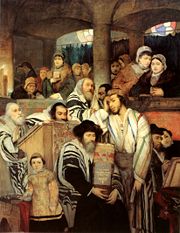
Judaism shares some of the characteristics of a nation, an ethnicity, a religion, and a culture, making the definition of who is a Jew vary slightly depending on whether a religious or national approach to identity is used.
Generally, in modern secular usage, Jews include three groups: people who practice Judaism and have some Jewish ancestral background or lineage (sometimes including those who do not have strictly matrilineal descent); people without any Jewish ancestral background or lineage who have formally converted to Judaism and are melding into an established Jewish community; and those Jews who, while not practicing Judaism as a religion, still identify themselves as Jewish by virtue of a lineage and their own cultural and historical identification with the Jewish people.
Historical definitions of Jewish identity have traditionally been based on halakhic definitions of matrilineal descent, and halakhic conversions. Historical definitions of who is a Jew date back to the codification of the oral tradition into the Babylonian Talmud. Interpretations of sections of the Tanach, such as Deuteronomy 7:1-5, by learned Jewish sages, are used as a warning against intermarriage between Jews and non-Jews because "[the non-Jewish male spouse] will cause your child to turn away from Me and they will worship the gods of others." Leviticus 24:10 says that the son in a marriage between a Hebrew woman and an Egyptian man is "of the community of Israel." This contrasts with Ezra 10:2-3, where Israelites returning from Babylon, vow to put aside their gentile wives and their children. Since the Haskalah, these halakhic interpretations of Jewish identity have been challenged.
Ethnic divisions
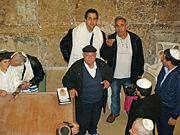
Within the world's Jewish population, which is considered a single self-identifying ethnic group, there are distinct ethnic divisions, most of which are primarily the result of geographic branching from an originating Israelite population, and subsequent independent evolutions.
An array of Jewish communities were established by Jewish settlers in various places around the Old World, often at great distances from one another resulting in practical, sometimes permanent, isolation from other Jewish communities. During the millennia of the Jewish diaspora the communities would evolve under the influence of their local environments; political, cultural, natural and populational. Today, manifestation of these differences among the Jewish ethnic division can be observed in Jewish cultural expressions of each community, Jewish linguistic diversity, and admixture among Jewish populations.
Historically, the ethnic divisions among Jews have been dominated by two major groups: the Ashkenazim, or "Germans" (Ashkenaz meaning "Germany" in Medieval Hebrew, denoting their Central European base), and the Sephardim, or "Spaniards" (Sefarad meaning "Spain" or " Iberia" in Hebrew, denoting their Spanish and Portuguese base). The Mizrahim, or "Easterners" (Mizrach being "East" in Hebrew), that is Middle Eastern, Central Asian, Caucasusian, and North African Jews, could constitute a third major group.
Smaller Jewish groups include the Indian Jews including the Bene Israel, Bnei Menashe, Cochin Jews and Bene Ephraim; the Romaniotes of Greece; the Italkim or Bené Roma of Italy; the Teimanim from the Yemen and Oman; various African Jews, including most numerously the Beta Israel of Ethiopia; and Chinese Jews, most notably the Kaifeng Jews, as well as various other distinct but now extinct communities.
The division between all these groups are rough and their boundaries aren’t solid. The Mizrahim for example, are a heterogeneous collection of North African, Central Asian , Caucasusian and Middle Eastern Jewish communities which are often as unrelated to each other as they are to any of the earlier mentioned Jewish groups. In modern usage, however, the Mizrahim are also termed Sephardi due to similar styles of liturgy, despite independent evolutions from Sephardim proper. Thus, among Mizrahim there are Iraqi Jews, Egyptian Jews, Berber Jews, Lebanese Jews, Kurdish Jews, Libyan Jews, Syrian Jews, Bukharian Jews, Mountain Jews, Georgian Jews and various others. The Teimanim from the Yemen and Oman are sometimes included, although their style of liturgy is unique and they differ in respect to the admixture found among them to that found in Mizrahim. Additionally, there is a differentiation made between the pre-existing Middle Eastern and North African Jewish communities as distinct from the descendants of those Sephardi migrants who established themselves in the Middle East and North Africa after the expulsion of the Jews from Spain by the Catholic Monarchs in 1492, and a few years later from the expulsion decreed in Portugal.
Despite this diversity, Ashkenazi Jews represent the bulk of modern Jewry, with at least 70% of Jews worldwide (and up to 90% prior to World War II and the Holocaust). As a result of their emigration from Europe during the wartime periods, Ashkenazim also represent the overwhelming majority of Jews in the New World continents and in countries previously without native Jewish communities, such as the United States, Canada, United Kingdom, Argentina, Australia, Brazil and South Africa. In France, emigration of Mizrahim from North Africa has led them to outnumber pre-existing European Jews. Only in Israel is the Jewish population representative of all groups, a melting pot independent of each group's proportion within the overall world Jewish population.
Population
Significant geographic populations
There are an estimated 13 million Jews worldwide. The table below lists countries with significant populations. Please note that these populations represent low-end estimates of the worldwide Jewish population, accounting for around 0.2% of the world's population.
| Country or Region | Jewish population | Total Population | % Jewish | Notes | |
|---|---|---|---|---|---|
| United States | 5,300,000 to 6,155,000 | 301,469,000 | 1.8%-1.9 | (est.) | |
| Israel | 5,393,400 | 7,116,700 | 75.8% | ||
| Europe | 2,000,000 | 710,000,000 | 0.3% | (less than) | |
| Belgium | 30,000 | 10,419,000 | 0.3% | (est.) | |
| France | 494,000 | 64,102,140 | 0.8% | (est.) | |
| Russia | 228,000 | 142,400,000 | 0.15% | (Territory of the former Soviet Union. (est.) Some estimates are much higher.) | |
| United Kingdom | 267,000 | 60,609,153 | 0.4% | (2001 census) | |
| Germany | 220,000 | 82,310,000 | 0.3% | (2004 est.), over 100,000 who are members of a synagogue | |
| Ukraine | 103,591 | 46,481,000 | 0.2% | (2001 Census) 250,000 to 500,000 (Local Jewish agency estimate) |
|
| Hungary | 80,000 to 100,000 | 10,053,000 | 0.8-1% | Hungarian Neolog Jews are part of the Hungarian nation. | |
| Italy | 30,000 | 58,883,958 | 0.05% | (Jewish communities est.) | |
| Canada | 371,000 | 32,874,400 | 1.1% | (est.) | |
| Turkey | 30,000 | 72,600,000 | 0.04% | (2001 census) | |
| Argentina | 250,000 | 39,921,833 | 0.6% | (est.) | |
| Brazil | 130,000 | 188,078,261 | 0.07% | (est.) | |
| South Africa | 106,000 | 47,432,000 | 0.2% | (est.) | |
| Peru | 23,789 | 56,788 | 1.2% | ||
| Australia | 126,000 | 20,788,357 | 0.6% | (est.) | |
| Asia (excl. Israel) | 50,000 | 3,900,000,000 | 0.001% | (est.) | |
| Iran | 20,405 | 68,467,413 | 0.03% | (est.) | |
| Mexico | 40,000–50,000 | 108,700,000 | 0.04% | (est.) | |
| Total | 15,871,000 | 6,453,628,000 | 0.25% | (est.) |
State of Israel
Israel, the Jewish nation-state, is the only country in which Jews make up a majority of the citizens. Israel was established as an independent democratic state on May 14, 1948. Of the 120 members in its parliament, the Knesset , currently, 12 members of the Knesset are Arab citizens of Israel, most representing Arab political parties and one of Israel's Supreme Court judges is a Palestinian Arab. Between 1948 and 1958, the Jewish population rose from 800,000 to two million. Currently, Jews account for 76.4% of the Israeli population, or 5,600,000 of the citizens. The early years of the state of Israel, were marked by the mass immigration of Holocaust survivors and Jews fleeing Arab lands. Israel also has a large population of Ethiopian Jews, many of whom were airlifted to Israel in the late 1980s and early 1990s. . Between 1974 and 1979 nearly 227,258 immigrants arrived in Israel about half from the Soviet Union. This period also saw an increase in immigration to Israel from Western Europe, Latin America, and the United States A trickle of immigrants from other communities has also arrived, including Indian Jews and others, as well as some descendants of Ashkenazi Holocaust survivors who had settled in countries such as the United States, Argentina and South Africa. Some Jews have emigrated from Israel elsewhere, due to economic problems or disillusionment with political conditions and the continuing Arab-Israeli conflict. Jewish Israeli emigrants are known as yordim.
Diaspora (outside Israel)
The waves of immigration to the United States and elsewhere at the turn of the nineteenth century and later due to various causes, including the pogroms in Russia, the massacre of European Jewry during the Holocaust, and the foundation of the state of Israel (and subsequent Jewish exodus from Arab lands), all resulted in substantial shifts in the population centers of world Jewry by the end the twentieth century.
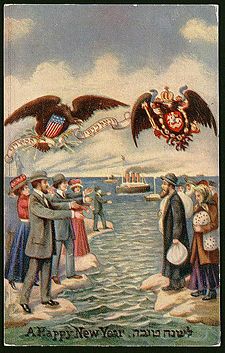
Currently, the largest Jewish community in the world is located in the United States, with almost 5.7 million Jews. Elsewhere in the Americas, there are also large Jewish populations in Canada, Argentina and Brazil, and smaller populations in Mexico(45,000), Uruguay, Venezuela, Chile, and several other countries (see History of the Jews in Latin America).
Western Europe's largest Jewish community can be found in France, home to 600,000 Jews, the majority of whom are immigrants or refugees from North African Arab countries such as Algeria, Morocco, and Tunisia (or their descendants). There are over 265,000 Jews in the United Kingdom. In Eastern Europe, there are anywhere from 500,000 to over two million Jews living in the former Soviet Union, but exact figures are difficult to establish. The fastest-growing Jewish community in the world, outside Israel, is the one in Germany, especially in Berlin, its capital. Tens of thousands of Jews from the former Eastern Bloc have settled in Germany since the fall of the Berlin Wall.
The Arab countries of North Africa and the Middle East were home to around 900,000 Jews in 1945. Fueled by anti-Zionism after the founding of Israel, systematic persecution caused almost all of these Jews to flee to Israel, North America, and Europe in the 1950s (see Jewish exodus from Arab lands). Today, around 8,000 Jews remain in Arab nations. Iran is home to around 25,000 Jews, down from a population of 100,000 Jews before the 1979 revolution. After the revolution some of the Iranian Jews emigrated to Israel or Europe but most of them emigrated (with their non-Jewish Iranian compatriots) to the United States (especially Los Angeles).
Outside Europe, Asia and the Americas, significant Jewish populations exist in Australia and South Africa.
Population changes: Assimilation
Since at least the time of the ancient Greeks, a proportion of Jews have assimilated into the wider non-Jewish society around them, by either choice or force, ceasing to practice Judaism and losing their Jewish identity. Some Jewish communities, for example the Kaifeng Jews of China, have disappeared entirely, but assimilation has remained relatively low over much of the past millennium, as Jews were often not allowed to integrate with the wider communities in which they lived. The advent of the Jewish Enlightenment (see Haskalah) of the 1700s and the subsequent emancipation of the Jewish populations of Europe and America in the 1800s, changed the situation, allowing Jews to increasingly participate in, and become part of, secular society. The result has been a growing trend of assimilation, as Jews marry non-Jewish spouses and stop participating in the Jewish community. Rates of interreligious marriage vary widely: In the United States, they are just under 50%, in the United Kingdom, around 50%, and in Australia and Mexico, as low as 10%, and in France, they may be as high as 75%. In the United States, only about a third of children from intermarriages affiliate themselves with Jewish religious practice. The result is that most countries in the Diaspora have steady or slightly declining religiously Jewish populations as Jews continue to assimilate into the countries in which they live.
Population changes: Wars against the Jews
Throughout history, many rulers, empires and nations have oppressed their Jewish populations or sought to eliminate them entirely. Methods employed ranged from expulsion to outright genocide; within nations, often the threat of these extreme methods was sufficient to silence dissent. The history of antisemitism includes the First Crusade which resulted in the massacre of Jews; the Spanish Inquisition (led by Torquemada) and the Portuguese Inquisition, with their persecution and Auto de fé against the New Christians and Marrano Jews; the Bohdan Chmielnicki Cossack massacres in Ukraine; the Pogroms backed by the Russian Tsars; as well as expulsions from Spain, Portugal, England, France, Germany, and other countries in which the Jews had settled. The persecution reached a peak in Adolf Hitler's Final Solution, which led to the Holocaust and the slaughter of approximately 6 million Jews from 1942 to 1945.
According to James Carroll, "Jews accounted for 10% of the total population of the Roman Empire. By that ratio, if other factors had not intervened, there would be 200 million Jews in the world today, instead of something like 13 million." Of course, there are many other complex demographic factors involved; the rate of population growth, migration, assimilation, and conversion could all have played major roles in the current size of the global Jewish population.
Population changes: Growth
Israel is the only country with a consistently growing Jewish population due to natural population increase, though the Jewish populations of other countries in Europe and North America have recently increased due to immigration. In the Diaspora, in almost every country the Jewish population in general is either declining or steady, but Orthodox and Haredi Jewish communities, whose members often shun birth control for religious reasons, have experienced rapid population growth, with rates near 4% per year for Haredi Jews in Israel, and similar rates in other countries.
Orthodox and Conservative Judaism discourage proselytization to non-Jews, but many Jewish groups have tried to reach out to the assimilated Jewish communities of the Diaspora in order to increase the number of Jews. Additionally, while in principle Reform Judaism favors seeking new members for the faith, this position has not translated into active proselytism, instead taking the form of an effort to reach out to non-Jewish spouses of intermarried couples. There is also a trend of Orthodox movements pursuing secular Jews in order to give them a stronger Jewish identity so there is less chance of intermarriage. As a result of the efforts by these and other Jewish groups over the past twenty-five years, there has been a trend of secular Jews becoming more religiously observant, known as the Baal Teshuva movement, though the demographic implications of the trend are unknown. Additionally, there is also a growing movement of Jews by Choice by gentiles who make the decision to head in the direction of becoming Jews.
Jewish languages
Hebrew is the liturgical language of Judaism (termed lashon ha-kodesh, "the holy tongue"), the language in which the Hebrew scriptures ( Tanakh) were composed, and the daily speech of the Jewish people for centuries. By the fifth century BCE, Aramaic, a closely related tongue, joined Hebrew as the spoken language in Judea. By the third century BCE, Jews of the diaspora were speaking Greek. Modern Hebrew is now one of the two official languages of the State of Israel along with Arabic.
Hebrew was revived as a spoken language by Eliezer ben Yehuda, who arrived in Palestine in 1881. It hadn't been used as a mother tongue since Tannaic times. For over sixteen centuries Hebrew was used almost exclusively as a liturgical language, and as the language in which most books had been written on Judaism, with a few speaking only Hebrew on the Sabbath. For centuries, Jews worldwide have spoken the local or dominant languages of the regions they migrated to, often developing distinctive dialectal forms or branching off as independent languages. Yiddish is the Judæo-German language developed by Ashkenazi Jews who migrated to Central Europe, and Ladino is the Judæo-Spanish language developed by Sephardic Jews who migrated to the Iberian peninsula. Due to many factors, including the impact of the Holocaust on European Jewry, the Jewish exodus from Arab lands, and widespread emigration from other Jewish communities around the world, ancient and distinct Jewish languages of several communities, including Gruzinic, Judæo-Arabic, Judæo-Berber, Krymchak, Judæo-Malayalam and many others, have largely fallen out of use.
While English is not a specifically Jewish language, the fact that the United States has a large Jewish community has led to English being a major language among Jewish people. The three most commonly spoken languages among Jews today are: English, modern Hebrew, and Russian, with some Romance languages also being widespread (such as French and Spanish).
Jewish culture
Judaism guides its adherents in both practice and belief, and has been called not only a religion, but also a "way of life," which has made drawing a clear distinction between Judaism, Jewish culture, and Jewish identity rather difficult.
Throughout history, in eras and places as diverse as the ancient Hellenic world, in Europe before and after The Age of Enlightenment (see Haskalah), in Islamic Spain and Portugal, in North Africa and the Middle East, India and China, or the contemporary United States and Israel, cultural phenomena have developed that are in some sense characteristically Jewish without being at all specifically religious. Some factors in this come from within Judaism, others from the interaction of Jews or specific communities of Jews with their surroundings, others from the inner social and cultural dynamics of the community, as opposed to from the religion itself. This phenomenon has led to considerably different Jewish cultures unique to their own communities, each as authentically Jewish as the next.
History of the Jews
Jews and migrations
Throughout Jewish history, Jews have repeatedly been directly or indirectly expelled from both their original homeland, and the areas in which they have resided. This experience as both immigrants and emigrants (see: Jewish refugees) have shaped Jewish identity and religious practice in many ways, and are thus a major element of Jewish history. An incomplete list of such migrations includes:
- The patriarch Abraham was a migrant to the land of Canaan from Ur of the Chaldees.
- The Children of Israel experienced the Exodus (meaning "departure" or "exit" in Greek) from ancient Egypt, as recorded in the Book of Exodus.
- The Kingdom of Israel was sent into permanent exile and scattered all over the world (or at least to unknown locations) by Assyria.
- The Kingdom of Judah was exiled by Babylonia, then returned to Judea, and then many were exiled again by the Roman Empire.
- The 2,000 year dispersion of the Jewish diaspora beginning under the Roman Empire, as Jews were spread throughout the Roman world and, driven from land to land, and settled wherever they could live freely enough to practice their religion. Over the course of the diaspora the centre of Jewish life moved from Babylonia to the Iberian Peninsula to Poland to the United States and to Israel.
- Many expulsions during the Middle Ages and Enlightenment in Europe, including: 1290, 16,000 Jews were expelled from England, see the ( Statute of Jewry); in 1396, 100,000 from France; in 1421 thousands were expelled from Austria. Many of these Jews settled in Eastern Europe, especially Poland.
- Following the Spanish Inquisition in 1492, the Spanish population of around 200,000 Sephardic Jews were expelled by the Spanish crown and Catholic church, followed by expulsions in 1493 in Sicily (37,000 Jews) and Portugal in 1496. The expelled Jews fled mainly to the Ottoman Empire, the Netherlands, and North Africa, others migrating to Southern Europe and the Middle East.
- During the 19th century, France's policies of equal citizenship regardless of religion led to the immigration of Jews (especially from Eastern and Central Europe), which was encouraged by Napoleon Bonaparte.
- The arrival of millions of Jews in the New World, including immigration of over two million Eastern European Jews to the United States from 1880-1925, see History of the Jews in the United States and History of the Jews in Russia and the Soviet Union.
- The Pogroms in Eastern Europe, the rise of modern Anti-Semitism, the Holocaust and the rise of Arab nationalism all served to fuel the movements and migrations of huge segments of Jewry from land to land and continent to continent, until they arrived back in large numbers at their original historical homeland in Israel.
- The Islamic Revolution of Iran forced many Iranian Jews to flee Iran. Most found refuge in the US (particularly Los Angeles, CA) and Israel. Smaller communities of Persian Jews exist in Canada and Western Europe.
- When the Soviet Union died, many of the Jews in the affected territory (who had been refuseniks) were suddenly allowed to leave. This produced a wave of migration to Israel in the early 1990s.
Kingdoms of Israel and Judah
Jews descend mostly from the ancient Israelites (also known as Hebrews), who settled in the Land of Israel. The Israelites traced their common lineage to the biblical patriarch Abraham through Isaac and Jacob. A United Monarchy was established under Saul and continued under King David and Solomon. King David conquered Jerusalem (first a Canaanite, then a Jebusite town) and made it his capital. After Solomon's reign, the nation split into two kingdoms, the Kingdom of Israel (in the north) and the Kingdom of Judah (in the south). The Kingdom of Israel was conquered by the Assyrian ruler Shalmaneser V in the 8th century BCE and spread all over the Assyrian empire, where they were assimilated into other cultures and came to be known as the Ten Lost Tribes. The Kingdom of Judah continued as an independent state until it was conquered by a Babylonian army in the early 6th century BCE, destroying the First Temple that was at the centre of Jewish worship. The Judean elite was exiled to Babylonia, but later at least a part of them returned to their homeland after the subsequent conquest of Babylonia by the Persians seventy years later, a period known as the Babylonian Captivity. A new Second Temple was constructed funded by Persian Kings, and old religious practices were resumed.
Persian, Greek, and Roman rule
- See related article Jewish-Roman wars.
The Seleucid Kingdom, which arose after the Persians were defeated by Alexander the Great, sought to introduce Greek culture into the Persian world. When the Greeks under Antiochus IV Epiphanes, supported by Hellenized Jews (those who had adopted Greek culture), attempted to convert the Jewish Temple to a temple of Zeus, the Jews revolted under the leadership of the Maccabees and rededicated the Temple to the Jewish God (hence the origins of Hanukkah) and created an independent Jewish kingdom known as the Hasmonaean Kingdom which lasted from 165 BCE to 63 BCE, when the kingdom came under influence of the Roman Empire. During the early part of Roman rule, the Hasmonaeans remained in power, until the family was annihilated by Herod the Great. Herod came from a wealthy Idumean family and became a very successful client king under the Romans. He significantly expanded the Temple in Jerusalem.
Upon his death in 4 BCE the Romans directly ruled Judea and there were frequent changes of policies by conflicting and empire-building Caesars, generals, governors, and consuls who often acted cruelly or to maximize their own wealth and power. Rome's attitudes swung from tolerance to hostility against its Jewish subjects, who had since moved throughout the Empire. The Romans, worshiping a large pantheon, could not readily accommodate the exclusive monotheism of Judaism, and the religious Jews could not accept Roman polytheism. (It was in this tumultuous climate that Christianity first emerged, among a small group of Jews.) After a famine and riots in 66 CE, the Jews in Judea began a revolt against Rome. The revolt was smashed by Titus Flavius, the son and successor of the Roman emperor Vespasian. In Rome the Arch of Titus still stands, showing enslaved Judeans and a menorah being brought to Rome. It is customary for Jews to walk around, rather than through, this arch.
The Romans all but destroyed Jerusalem; only a single " Western Wall" of the Second Temple remained. After the end of this first revolt, the Jews continued to live in their land in significant numbers, and were allowed to practice their religion. In the second century the Roman Emperor Hadrian began to rebuild Jerusalem as a pagan city while restricting some Jewish practices. Angry at this affront, the Jews again revolted led by Simon Bar Kokhba. Hadrian responded with overwhelming force, putting down the revolt and killing as many as half a million Jews. After the Roman Legions prevailed in 135, Jews were not allowed to enter the city of Jerusalem and most Jewish worship was forbidden by Rome. Following the destruction of Jerusalem and the expulsion of the Jews, Jewish worship stopped being centrally organized around the Temple, and instead the rabbis took on a more prominent position as teachers and leaders of individual communities. No new books were added to the Jewish Bible after the Roman period, instead major efforts went into interpreting and developing the Halakhah, or oral law, and writing down these traditions in the Talmud, the key work on the interpretation of Jewish law, written during the first to fifth centuries CE.
Beginning of the Diaspora
Though Jews had settled outside Israel since the time of the Babylonians, the results of the Roman response to the Jewish revolt shifted the centre of Jewish life from its ancient home to the diaspora. While some Jews remained in Judea, renamed Palestine by the Romans, some Jews were sold into slavery, while others became citizens of other parts of the Roman Empire. This is the traditional explanation to the Jewish diaspora, almost universally accepted by past and present rabbinical or Talmudical scholars, who believe that Jews are almost exclusively biological descendants of the Judean exiles. Some secular historians speculate that a majority of the Jews in Antiquity were most likely descendants of converts in the cities of the Græco-Roman world, especially in Alexandria and Asia Minor. They were only affected by the diaspora in its spiritual sense and by the sense of loss and homelessness which became a cornerstone of the Jewish creed, much supported by persecutions in various parts of the world. Any such policy of conversion, which spread the Jewish religion throughout Hellenistic civilization, seems to have ended with the wars against the Romans and the following reconstruction of Jewish values for the post-Temple era. DNA evidence of this theory has been spotty, however, some historians believe based on some historical records that at the dawn of Christianity as many as 10% of the population of the Roman Empire were Jewish, a figure that could only be explained by local conversion. This theory could also solve the paradox of DNA studies noted above that show Ashkenazi Jews to be related to the peoples of the nations surrounding Israel and being relatively far from their European neighbours, despite physical features that sometimes are more closely resembles that of the peoples of southern and central Europe; as one explanation would be a large miscegenation millennia ago followed by almost no outside genetic contact thereafter. These types of assumptions are not supported by any historical account, and the extent of similarities in physical features between Ashkenazi Jews and non-Jewish Europeans is disputed.
During the first few hundred years of the Diaspora, the most important Jewish communities were in Babylonia, where the Babylonian Talmud was written, and where relatively tolerant regimes allowed the Jews freedom. The situation was worse in the Byzantine Empire which treated the Jews much more harshly, refusing to allow them to hold office or build places of worship. In the belief of restoration to come, the Jews made an alliance with the Persians who invaded Palestine in 614, fought at their side, overwhelmed the Byzantine garrison in Jerusalem, and for three years governed the city. But the Persians made their peace with the Emperor Heraclius. Christian rule was re-established, and those Jews who survived the consequent slaughter were once more banished from Jerusalem.
The conquest of much of the Byzantine Empire and Babylonia by Islamic armies generally improved the life of the Jews, though they were still considered second-class citizens. In response to these Islamic conquests, the First Crusade of 1096 attempted to reconquer Jerusalem, resulting in the destruction of many of the remaining Jewish communities in the area. The Jews were among the most vigorous defenders of Jerusalem against the Crusaders. When the city fell, the Crusaders gathered the Jews in a synagogue and burned them. The Jews almost single-handedly defended Haifa against the Crusaders, holding out in the besieged town for a whole month (June-July 1099). At this time, a full thousand years after the fall of the Jewish state, there were Jewish communities all over the country. Fifty of them are known to us; they include Jerusalem, Tiberias, Ramleh, Ashkelon, Caesarea, and Gaza.
Middle Ages: Europe
Jews settled in Europe during the time of the Roman Empire, but the rise of the Roman Catholic Church resulted in frequent expulsions and persecutions. The Crusades routinely attacked Jewish communities, and increasingly harsh laws restricted them from most economic activity and land ownership, leaving open only money-lending and a few other trades. Jews were subject to expulsions from England, France, and the Holy Roman Empire throughout the Middle Ages, with most of the population moving to Eastern Europe and especially Poland, which was uniquely tolerant of the Jews through the 1700s. The final mass expulsion of the Jews, and the largest, occurred after the Christian conquest ( Reconquista) of Iberia in 1492 (see History of the Jews in Spain and History of the Jews in Portugal). Even after the end of the expulsions in the 17th century, individual conditions varied from country to country and time to time, but, as rule, Jews in Western Europe generally were forced, by decree or by informal pressure, to live in highly segregated ghettos and shtetls. By the beginning of the twentieth century, most European Jews lived in the so-called Pale of Settlement, the Western frontier of the Russian Empire consisting generally of the modern-day countries of Poland, Lithuania, Belarus and neighboring regions.
Middle Ages: Islamic Europe, North Africa, Middle East
In the Iberian Peninsula, under Muslim rule, Jews were able to make great advances in mathematics, astronomy, philosophy, chemistry and philology. This era is sometimes referred to as the Golden age of Jewish culture in the Iberian Peninsula.
During early Islam, Leon Poliakov writes, Jews enjoyed great privileges, and their communities prospered. There was no legislation or social barriers preventing them from conducting commercial activities. Many Jews migrated to areas newly conquered by Muslims and established communities there. The vizier of Baghdad entrusted his capital with Jewish bankers. The Jews were put in charge of certain parts of maritime and slave trade. Siraf, the principal port of the caliphate in the 10th century CE, had a Jewish governor.
Throughout history, there have been numerous instances of pogroms against Jews. Examples include the 1066 Granada massacre, where the razing of the entire Jewish quarter in the Andalucian city of Granada in 1066. In North Africa, there were cases of violence against Jews in the Middle Ages, and in other Arab lands including Egypt, Syria and Yemen.
The Almohads, who had taken control of much of Islamic Iberia by 1172, far surpassed the Almoravides in fundamentalist outlook, and they treated the dhimmis harshly. Jews and Christians were expelled from Morocco and Islamic Spain. Faced with the choice of either death or conversion, some Jews, such as the family of Maimonides, fled south and east to the more tolerant Muslim lands, while others went northward to settle in the growing Christian kingdoms.
Enlightenment and emancipation
During the Age of Enlightenment, significant changes occurred within the Jewish community. The Haskalah movement paralleled the wider Enlightenment, as Jews began in the 1700s to campaign for emancipation from restrictive laws and integration into the wider European society. Secular and scientific education was added to the traditional religious instruction received by students, and interest in a national Jewish identity, including a revival in the study of Jewish history and Hebrew, started to grow.
The Haskalah movement influenced the birth of all the modern Jewish denominations, and planted the seeds of Zionism. At the same time, it contributed to encouraging cultural assimilation into the countries in which Jews resided. At around the same time another movement was born, one preaching almost the opposite of Haskalah, Hasidic Judaism. Hasidic Judaism began in the 1700s by Israel ben Eliezer, the Baal Shem Tov, and quickly gained a following with its exuberant, mystical approach to religion. These two movements, and the traditional orthodox approach to Judaism from which they spring, formed the basis for the modern divisions within Jewish observance.
At the same time, the outside world was changing. France was the first country to emancipate its Jewish population in 1796, granting them equal rights under the law. Napoleon further spread emancipation, inviting Jews to leave the Jewish ghettos in Europe and seek refuge in the newly created tolerant political regimes (see Napoleon and the Jews). Other countries such as Denmark, England, and Sweden also adopted liberal policies toward Jews during the period of Enlightenment, with some resulting immigration. By the mid-19th century, almost all Western European countries had emancipated their Jewish populations, with the notable exception of the Papal States, but persecution continued in Eastern Europe including massive pogroms at the end of the 19th century and throughout the Pale of Settlement. The persistence of anti-semitism, both violently in the east and socially in the west, led to a number of Jewish political movements, culminating in Zionism.
Zionism and emigration from Europe
Zionism is an international political movement that supports a homeland for the Jewish People in the Land of Israel. Although its origins are earlier, the movement was formally established by Austrian journalist Theodor Herzl in the late nineteenth century. The international movement was eventually successful in establishing the State of Israel in 1948, as the world's first and only modern Jewish State. It continues primarily as support for the state and government of Israel and its continuing status as a homeland for the Jewish people. Described as a " diaspora nationalism," its proponents regard it as a national liberation movement whose aim is the self-determination of the Jewish people.
While Zionism is based in part upon religious tradition linking the Jewish people to the Land of Israel, where the concept of Jewish nationhood is thought to have first evolved somewhere between 1200 BCE and the late Second Temple era (i.e. up to 70 AD), the modern movement was mainly secular, beginning largely as a response by European Jewry to rampant antisemitism across Europe.
In addition to responding politically, during the late 19th century, Jews began to flee the persecutions of Eastern Europe in large numbers, mostly by heading to the United States, but also to Canada and Western Europe. By 1924, almost two million Jews had emigrated to the US alone, creating a large community in a nation relatively free of the persecutions of rising European antisemitism (see History of the Jews in the United States).
The Holocaust
This antisemitism reached its most destructive form in the policies of Nazi Germany, which made the destruction of the Jews a priority, culminating in the killing of approximately six million Jews during the Holocaust from 1941 to 1945., Originally, the Nazis used death squads, the Einsatzgruppen, to conduct massive open-air killings of Jews in territory they conquered. By 1942, the Nazi leadership decided to implement the Final Solution, the genocide of the Jews of Europe, and to increase the pace of the Holocaust by establishing extermination camps specifically to kill Jews. This was an industrial method of genocide. Millions of Jews who had been confined to diseased and massively overcrowded Ghettos were transported (often by train) to "Death-camps" where some were herded into a specific location (often a gas chamber), then either gassed or shot. Afterwards, their remains were buried or burned. Others were interned in the camps where they were given little food and disease was common.
Israel
In 1948, the Jewish state of Israel was founded., creating the first Jewish nation since the Roman destruction of Jerusalem. After the 1948 Arab-Israeli War, the majority of the 850,000 Jews previously living in North Africa and the Middle East fled to Israel., joining an increasing number of immigrants from post-War Europe (see Jewish exodus from Arab lands). By the end of the 20th century, Jewish population centers had shifted dramatically, with the United States and Israel being the centers of Jewish secular and religious life.
Persecution
-
- Related articles: Antisemitism, History of antisemitism, New antisemitism
The Jewish people and Judaism have experienced various persecutions throughout Jewish history. During late Antiquity and the early Middle Ages the Roman Empire (in its later phases known as the Byzantine Empire) repeatedly repressed the Jewish population, first by ejecting them from their homelands during the pagan Roman era and later by officially establishing them as second-class citizens during the Christian Roman era. Later in medieval Western Europe, further persecutions of Jews in the name of Christianity occurred, notably during the Crusades—when Jews all over Germany were massacred—and a series of expulsions from England, Germany, France, and, in the largest expulsion of all, Spain and Portugal after the Reconquista of the Iberian Peninsula from Muslim Moors. In the Papal States, which existed until 1870, Jews were required to live only in specified neighborhoods called ghettos. In the 19th and (before the end of the second World War) 20th centuries, the Roman Catholic church adhered to a distinction between "good antisemitism" and "bad antisemitism". The "bad" kind promoted hatred of Jews because of their descent. This was considered un-Christian because the Christian message was intended for all of humanity regardless of ethnicity; anyone could become a Christian. The "good" kind criticized alleged Jewish conspiracies to control newspapers, banks, and other institutions, to care only about accumulation of wealth, etc.
Islam and Judaism have a complex relationship. Traditionally Jews living in Muslim lands, known as dhimmis, were allowed to practice their religion and to administer their internal affairs, but subject to certain conditions. They had to pay the jizya (a per capita tax imposed on free adult non-Muslim males) to Muslims. Dhimmis had an inferior status under Islamic rule. They had several social and legal disabilities such as prohibitions against bearing arms or giving testimony in courts in cases involving Muslims. Many of the disabilities were highly symbolic. The most degrading one was the requirement of distinctive clothing, not found in the Qur'an or hadith but invented in early medieval Baghdad; its enforcement was highly erratic. Jews rarely faced martyrdom or exile, or forced compulsion to change their religion, and they were mostly free in their choice of residence and profession. The notable examples of massacre of Jews include the killing or forcibly conversion of them by the rulers of the Almohad dynasty in Al-Andalus in the 12th century. Notable examples of the cases where the choice of residence was taken away from them includes confining Jews to walled quarters ( mellahs) in Morocco beginning from the 15th century and especially since the early 19th century. There were some forced conversions in the 12th century under the Almohad dynasty of North Africa and al-Andalus as well as in Persia. Standard antisemitic themes have become commonplace in the propaganda of Arab Islamic movements such as Hizbullah and Hamas, in the pronouncements of various agencies of the Islamic Republic of Iran, and even in the newspapers and other publications of Refah Partisi."
The most notable modern day persecution of Jews remains the Holocaust — the state-led systematic persecution and genocide of the Jews (and other minority groups) of Europe and European Colonial North Africa during World War II by Nazi Germany and its collaborators The persecution and genocide were accomplished in stages. Legislation to remove the Jews from civil society was enacted years before the outbreak of World War II. Concentration camps were established in which inmates were used as slave labour until they died of exhaustion or disease. Where the Third Reich conquered new territory in eastern Europe, specialized units called Einsatzgruppen murdered Jews and political opponents in mass shootings. Jews and Roma were crammed into ghettos before being transported hundreds of miles by freight train to extermination camps where, if they survived the journey, the majority of them were killed in gas chambers. Every arm of Germany's bureaucracy was involved in the logistics of the mass murder, turning the country into what one Holocaust scholar has called "a genocidal nation."
Jewish leadership
There is no single governing body for the Jewish community, nor a single authority with responsibility for religious doctrine. Instead, a variety of secular and religious institutions at the local, national, and international levels lead various parts of the Jewish community on a variety of issues.
Famous Jews
Jews have made contributions in a broad range of human endeavors, including the sciences, arts, politics, business, etc. The number of Jewish Nobel prize winners (approximately 160 in all), is far out of proportion to the percentage of Jews in the world's population.
